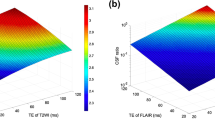Abstract
Background
The clinical application of the multi-echo, multi-delay technique of synthetic magnetic resonance imaging (MRI) generates multiple sequences in a single acquisition but has mainly been used in adults.
Objective
To evaluate the image quality of synthetic brain MR in children compared with that of conventional images.
Materials and methods
Twenty-nine children (median age: 6 years, range: 0–16 years) underwent synthetic and conventional imaging. Synthetic (T2-weighted, T1-weighted and fluid-attenuated inversion recovery [FLAIR]) images with settings matching those of the conventional images were generated. The overall image quality, gray/white matter differentiation, lesion conspicuity and image degradations were rated on a 5-point scale. The relative contrasts were assessed quantitatively and acquisition times for the two imaging techniques were compared.
Results
Synthetic images were inferior due to more pronounced image degradations; however, there were no significant differences for T1- and T2-weighted images in children <2 years old. The quality of T1- and T2-weighted images were within the diagnostically acceptable range. FLAIR images showed greatly reduced quality. Gray/white matter differentiation was comparable or better in synthetic T1- and T2-weighted images, but poorer in FLAIR images. There was no effect on lesion conspicuity. Synthetic images had equal or greater relative contrast. Acquisition time was approximately two-thirds of that for conventional sequences.
Conclusion
Synthetic T1- and T2-weighted images were diagnostically acceptable, but synthetic FLAIR images were not. Lesion conspicuity and gray/white matter differentiation were comparable to conventional MRI.




Similar content being viewed by others
References
Riederer SJ, Suddarth SA, Bobman SA et al (1984) Automated MR image synthesis: feasibility studies. Radiology 153:203–206
Warntjes JB, Leinhard OD, West J et al (2008) Rapid magnetic resonance quantification on the brain: optimization for clinical usage. Magn Reson Med 60:320–329
Warntjes JB, Dahlqvist O, Lundberg P (2007) Novel method for rapid, simultaneous T1, T2*, and proton density quantification. Magn Reson Med 57:528–537
Blystad I, Warntjes JB, Smedby O et al (2012) Synthetic MRI of the brain in a clinical setting. Acta Radiol 53:1158–1163
Granberg T, Uppman M, Hashim F et al (2016) Clinical feasibility of synthetic MRI in multiple sclerosis: a diagnostic and volumetric validation study. AJNR Am J Neuroradiol 37:1023–1029
Krauss W, Gunnarsson M, Andersson T et al (2015) Accuracy and reproducibility of a quantitative magnetic resonance imaging method for concurrent measurements of tissue relaxation times and proton density. Magn Reson Imaging 33:584–591
West J, Warntjes JB, Lundberg P (2012) Novel whole brain segmentation and volume estimation using quantitative MRI. Eur Radiol 22:998–1007
Ambarki K, Lindqvist T, Wahlin A et al (2012) Evaluation of automatic measurement of the intracranial volume based on quantitative MR imaging. AJNR Am J Neuroradiol 33:1951–1956
Vagberg M, Lindqvist T, Ambarki K et al (2013) Automated determination of brain parenchymal fraction in multiple sclerosis. AJNR Am J Neuroradiol 34:498–504
Betts AM, Leach JL, Jones BV et al (2016) Brain imaging with synthetic MR in children: clinical quality assessment. Neuroradiology 58:1017–1026
West H, Leach JL, Jones BV et al (2017) Clinical validation of synthetic brain MRI in children: initial experience. Neuroradiology 59:43–50
Dietrich RB, Bradley WG, Zaragoza EJ 4th et al (1988) MR evaluation of early myelination patterns in normal and developmentally delayed infants. AJR Am J Roentgenol 150:889–896
Barkovich AJ, Kjos BO, Jackson DE Jr et al (1988) Normal maturation of the neonatal and infant brain: MR imaging at 1.5 T. Radiology 166:173–180
Saunders DE, Thompson C, Gunny R et al (2007) Magnetic resonance imaging protocols for paediatric neuroradiology. Pediatr Radiol 37:789–797
Whittall KP, MacKay AL, Li DK (1999) Are mono-exponential fits to a few echoes sufficient to determine T2 relaxation for in vivo human brain? Magn Reson Med 41:1255–1257
Hagiwara A, Hori M, Yokoyama K et al (2017) Synthetic MRI in the detection of multiple sclerosis plaques. AJNR Am J Neuroradiol 38:257–263
Nelson F, Poonawalla AH, Hou P et al (2007) Improved identification of intracortical lesions in multiple sclerosis with phase-sensitive inversion recovery in combination with fast double inversion recovery MR imaging. AJNR Am J Neuroradiol 28:1645–1649
Hagiwara A, Hori M, Yokoyama K et al (2017) Utility of a multiparametric quantitative MRI model that assesses myelin and edema for evaluating plaques, periplaque white matter, and normal-appearing white matter in patients with multiple sclerosis: a feasibility study. AJNR Am J Neuroradiol 38:237–242
Warntjes M, Engstrom M, Tisell A et al (2016) Modeling the presence of myelin and edema in the brain based on multi-parametric quantitative MRI. Front Neurol 7:16
Author information
Authors and Affiliations
Corresponding author
Ethics declarations
Conflicts of interest
None
Rights and permissions
About this article
Cite this article
Lee, S.M., Choi, Y.H., Cheon, JE. et al. Image quality at synthetic brain magnetic resonance imaging in children. Pediatr Radiol 47, 1638–1647 (2017). https://doi.org/10.1007/s00247-017-3913-y
Received:
Revised:
Accepted:
Published:
Issue Date:
DOI: https://doi.org/10.1007/s00247-017-3913-y




